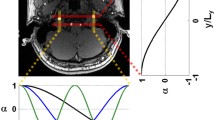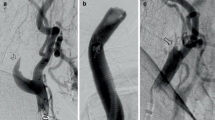Abstract
Xenon-enhanced computed tomography (XeCT) allows quantification of hemodynamic insufficiency in the setting of cerebrovascular atherosclerotic disease (CAD). However, data regarding the relationship between hemodynamic indices [cerebral blood flow (CBF) and cerebrovascular reserve capacity (CVRC)] and normal subjects (with aging) and pathology (progression of CAD or development of stroke symptoms) are limited. In this study, we analyzed 103 consecutive patients undergoing XeCT according to age, anatomical location and disease severity. We stratified anatomically defined ROIs according to a classification system that observes the presence of proximal stenosis (class I vs. class II/III) as well as the presence of neurological symptoms (class II vs. III); CBF, CVRC and hemodynamic stress distribution were calculated. Supratentorial CBF decreases significantly with age, but not infratentorially. Cortical CVRC remains stable over time. Our classification of disease severity correlated highly significantly with a decrease in supratentorial CBF and CVRC, though CVRC is less sensitive to age-related changes. Regression analysis delineated a CVRC of 34% to discriminate between ROI classes. Age-dependent perfusion characteristics in normal vascular territories were characterized. In CAD, CVRC remains the most sensitive parameter. A simplified classification of ROIs according to disease severity correlates well with established markers for hemodynamic insufficiency. It may facilitate comparison of different pathologies such as CAD and Moyamoya disease and will be the focus of further studies.



Similar content being viewed by others
Abbreviations
- XeCT:
-
Xenon-enhanced computed tomography
- CBF:
-
cerebral blood flow
- CAD:
-
cerebrovascular atherosclerotic disease
- MMD:
-
Moyamoya disease
- ROI:
-
region of interest
- CVRC:
-
cerebrovascular reserve capacity
- ICA:
-
internal carotid artery
- MCA:
-
middle cerebral artery
- hdSD:
-
hemodynamic stress distribution
References
Webster MW, Makaroun MS, Steed DL, Smith HA, Johnson DW, Yonas H, et al. Compromised cerebral blood flow reactivity is a predictor of stroke in patients with symptomatic carotid artery occlusive disease. J Vasc Surg. 1995;21(2):338–44. discussion 344–5.
Lee M, Zaharchuk G, Guzman R, Achrol A, Bell-Stephens T, Steinberg GK. Quantitative hemodynamic studies in moyamoya disease: a review. Neurosurg Focus. 2009;26(4):E5.
Wintermark M, Sesay M, Barbier E, Borbely K, Dillon WP, Eastwood JD, et al. Comparative overview of brain perfusion imaging techniques. Stroke. 2005;36(9):e83–99.
Yonas H, Darby JM, Marks EC, Durham SR, Maxwell C. CBF measured by xe-ct: approach to analysis and normal values. J Cereb Blood Flow Metab. 1991;11(5):716–25.
Schmiedek P, Piepgras A, Leinsinger G, Kirsch CM, Einhäupl K. Improvement of cerebrovascular reserve capacity by EC–IC arterial bypass surgery in patients with ICA occlusion and hemodynamic cerebral ischemia. J Neurosurg. 1994;81(2):236–44.
Yonas H, Gur D, Good BC, Latchaw RE, Wolfson SKJ, Good WF, et al. Stable xenon CT blood flow mapping for evaluation of patients with extracranial–intracranial bypass surgery. J Neurosurg. 1985;62(3):324–33.
Yonas H, Smith HA, Durham SR, Pentheny SL, Johnson DW. Increased stroke risk predicted by compromised cerebral blood flow reactivity. J Neurosurg. 1993;79(4):483–9.
Buijs PC, Krabbe-Hartkamp MJ, Bakker CJ, de Lange EE, Ramos LM, Breteler MM, et al. Effect of age on cerebral blood flow: measurement with ungated two-dimensional phase-contrast MR angiography in 250 adults. Radiology. 1998;209(3):667–74.
Chaer RA, Shen J, Rao A, Cho JS, Abu Hamad G, Makaroun MS. Cerebral reserve is decreased in elderly patients with carotid stenosis. J Vasc Surg 2010, Jul 9.
Kohno K, Oka Y, Kohno S, Ohta S, Kumon Y, Sakaki S. Cerebral blood flow measurement as an indicator for an indirect revascularization procedure for adult patients with moyamoya disease. Neurosurgery. 1998;42(4):752–7. discussion 757–8.
Angeloni U, Bozzao L, Fantozzi L, Bastianello S, Kushner M, Fieschi C. Internal borderzone infarction following acute middle cerebral artery occlusion. Neurology. 1990;40(8):1196–8.
Del Sette M, Eliasziw M, Streifler JY, Hachinski VC, Fox AJ, Barnett HJ. Internal borderzone infarction: a marker for severe stenosis in patients with symptomatic internal carotid artery disease. For the North American Symptomatic Carotid Endarterectomy (NASCET) group. Stroke. 2000;31(3):631–6.
Gur D, Good WF, Wolfson SKJ, Yonas H, Shabason L. In vivo mapping of local cerebral blood flow by xenon-enhanced computed tomography. Science. 1982;215(4537):1267–8.
Johnson DW, Stringer WA, Marks MP, Yonas H, Good WF, Gur D. Stable xenon CT cerebral blood flow imaging: rationale for and role in clinical decision making. AJNR Am J Neuroradiol. 1991;12(2):201–13.
Kashiwagi S, Yamashita T, Katoh S, Kitahara T, Nakashima K, Yasuhara S, et al. Regression of moyamoya vessels and hemodynamic changes after successful revascularization in childhood moyamoya disease. Acta Neurol Scand Suppl. 1996;166:85–8.
Derdeyn CP, Videen TO, Fritsch SM, Carpenter DA, Grubb RLJ, Powers WJ. Compensatory mechanisms for chronic cerebral hypoperfusion in patients with carotid occlusion. Stroke. 1999;30(5):1019–24.
Leenders KL, Perani D, Lammertsma AA, Heather JD, Buckingham P, Healy MJ, et al. Cerebral blood flow, blood volume and oxygen utilization. Normal values and effect of age. Brain. 1990;113(Pt 1):27–47.
Yonas H, Pindzola RR, Meltzer CC, Sasser H. Qualitative versus quantitative assessment of cerebrovascular reserves. Neurosurgery. 1998;42(5):1005–10. discussion 1011–2.
Schubert GA, Seiz M, Hegewald AA, Manville J, Thomé C. Acute hypoperfusion immediately after subarachnoid hemorrhage: a xenon contrast-enhanced CT study. J Neurotrauma. 2009;26(12):2225–31.
Przybylski GJ, Yonas H, Smith HA. Reduced stroke risk in patients with compromised cerebral blood flow reactivity treated with superficial temporal artery to distal middle cerebral artery bypass surgery. J Stroke Cerebrovasc Dis. 1998;7(5):302–9.
Author information
Authors and Affiliations
Corresponding author
Rights and permissions
About this article
Cite this article
Schubert, G.A., Seiz, M., Czabanka, M. et al. Perfusion Characteristics in Chronic Cerebrovascular Insufficiency. Transl. Stroke Res. 3, 122–129 (2012). https://doi.org/10.1007/s12975-011-0107-z
Received:
Revised:
Accepted:
Published:
Issue Date:
DOI: https://doi.org/10.1007/s12975-011-0107-z




